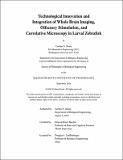Technological Innovation and Integration of Whole Brain Imaging, Olfactory Stimulation, and Correlative Microscopy in Larval Zebrafish
Author(s)
Swain, Corban N.
DownloadThesis PDF (169.4Mb)
Advisor
Boyden, Edward Stuart
Terms of use
Metadata
Show full item recordAbstract
Achieving a deep understanding of the brain is a cross-disciplinary endeavor that requires the investigator to consider biomolecular, electrical, and sensory interactions across time and space at many scales. This understanding is important because a deeper understanding of the brain precedes advancements in efficient computing, generalizable frameworks for learning, and, of critical importance, the understanding and treatment of neurological diseases. Towards this end, this thesis presents novel approaches and technologies for whole-brain imaging, olfactory stimulation, and correlative imaging---i.e. the utilization and registration of multiple imaging modalities within a single sample. The overall objective of this thesis research is to not just create technologies, but to integrate them to enabler richer and more contextual understandings of the larval zebrafish's brain.
In this work we show novel light field microscopy algorithms that allow us to reconstruct 3D images from 2D micrographs with improved resolution to enable high-frame-rate recordings of whole-brain neural activity. We describe the designing and building of the first known system for multi-directional olfactory stimulation of larval zebrafish with up to ten separate odor channels. We demonstrate an optimized expansion microscopy-compatible immunostaining protocol for whole-mount zebrafish which preserves registration epitopes to move towards the neuron-level alignment of structural and functional data. And, finally, we showcase a set of proof-of-concept experiments and analyses which demonstrate our ability to integrate olfactory stimulation, whole-brain calcium imaging, behavioral recording, and structural staining in individual larva.
Date issued
2024-09Department
Massachusetts Institute of Technology. Department of Biological EngineeringPublisher
Massachusetts Institute of Technology